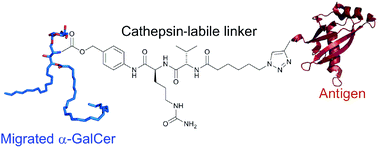NKT cell-dependent glycolipid–peptide vaccines with potent anti-tumour activity†
Abstract
It is known that T cells can eliminate tumour cells through recognition of unique or aberrantly expressed antigens presented as peptide epitopes by major histocompatibility complex (MHC) molecules on the tumour cell surface. With recent advances in defining tumour-associated antigens, it should now be possible to devise therapeutic vaccines that expand specific populations of anti-tumour T cells. However there remains a need to develop simpler efficacious synthetic vaccines that possess clinical utility. We present here the synthesis and analysis of vaccines based on conjugation of MHC-binding peptide epitopes to α-galactosylceramide, a glycolipid presented by the nonpolymorphic antigen-presenting molecule CD1d to provoke the stimulatory activity of type I natural killer T (NKT) cells. The chemical design incorporates an enzymatically cleavable linker that effects controlled release of the active components in vivo. Chemical and biological analysis of different linkages with different enzymatic targets enabled selection of a synthetic vaccine construct with potent therapeutic anti-tumour activity in mice, and marked in vitro activity in human blood.



 Please wait while we load your content...
Please wait while we load your content...